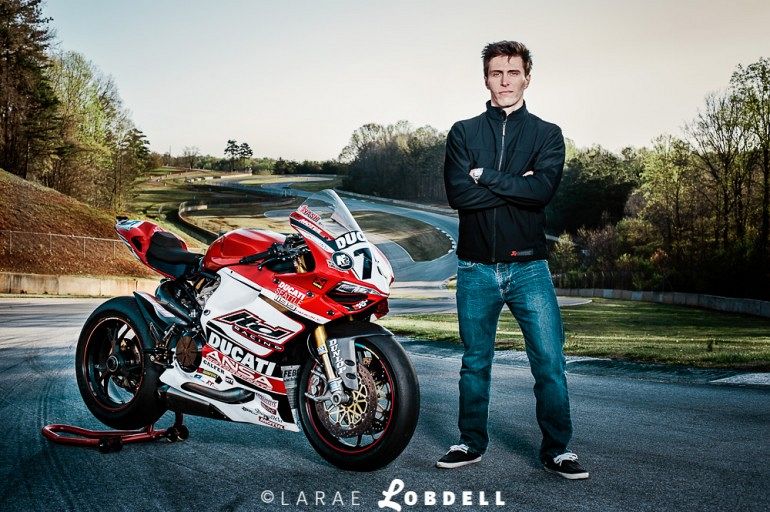Here's everything you need to know about Huntley Nash's LTD Racing Ducati Panigale Superbike: forget everything you thought you knew about big v-twins.
Well, almost everything. The 1199cc Superquadro powerplant does make monstrous, gut-compressing torque. Rolling on the throttle in third gear seems less to rocket you forward, and more to spin the planet on its foundations beneath you. The bike doesn't care what gear it's in; the torque is everywhere, from idle to redline, and it never stops pulling. The power curve surges in a crescendo that would be interminable, if it weren't for the rev limiter. The easy speed of the bike makes the track seem very small. Brake markers fly at you; straightaways disappear altogether. The rear tire squirms under the strain of translating all that power into traction, and the front of the bike shakes its head like an angry stallion.
That's where my expectations of the bike ended, and the discovery of its true nature began. While it squirmed, it never threatened to spit me off, even with the traction control system disabled. The rush of power was extreme, but linear and predictable. The bike moved around, but in such a way that you wanted only to move with it, rather than try and correct it. The Panigale superbike scoffs at conventional wisdom regarding big v-twins. Far from the heavy, lugging, ill-tempered twins of the past, the Panigale is a supremely refined machine.
To say that it's light is an oversimplification. Everything about this bike is light. The overall weight, the lever actions, the throttle, the revving of the motor, the steering. Turning into a corner and transitioning from right to left happens with so little effort that you have only to wish it so, and your knee is already on the ground. It finds apexes like laser guided missiles find targets. The body position is akin to a modern 600cc machine, slender in the middle and instantly comfortable, even with my gangly, 6-foot frame on board.
But before you find out any of that, you hear the noise. The visceral roar of a racing Ducati is a symphony to the ears of any race fan, but riding Nash's Panigale was like sitting in the orchestra pit at Carnegie Hall. The sound surrounds you as if you were inside one of the huge, 112mm cylinders, drowning out all else and connecting you to the bike. To be clear, it isn't painfully loud, as a screaming inline-4 might be. The tone is full and throaty, and simply envelops you in its power.
The LTD Racing Panigale was built under the careful direction of Nash's chief mechanic, Jon Shiereck. Jon has been working with Panigales since their debut in 2011, and has a deep understanding of what's needed to take them from a fire-breathing hooligan machine for the street, to a finely honed track weapon. Jon lobbied LTD to take on the Ducati for this season primarily because the baseline package was so good. Many of the parts that would have to be purchased to turn a Japanese bike into a proper Superbike were already present on the Panigale, making the end costs for a race-ready machine substantially lower.
The bike Huntley is riding this year features an engine built by Desmomaniacs Racing, and a modified fuel tank and rear suspension parts from Desmo Veloce. The Öhlins gas-charged forks and rear shock were built by Eric Gray of GMD Computrack, and the chassis angles sweetened by custom triple clamps and steering head inserts.
Perhaps the most impressive modification that sets this Panigale apart from its road-going cousins is the electronics package. The LTD Panigale is running a full Motec suite, which includes traction control, launch and wheelie control, data logging, and custom fuel maps that can be tweaked for individual segments of each track. The system is intricate and complex, and the job of learning it falls to Shiereck. That job is made more challenging by being the only Panigale in the world running the full Motec system.
Most of the functions provided by the Motec system are transparent to the rider. When TC is working correctly, you don't notice it's there. But the ECU also provides for upshifts and downshifts without the clutch, matching the revs to the new gear the instant the shift lever is touched. Leaving my hand off the clutch was hard to wrap my head around, and the shifting seems harsh unless you're pushing the bike, but the advantage of such a system was clear even after a few laps well off race pace.
Modern production motorcycles are extremely capable machines. We've documented right here on RideApart how easy it is to take a sportbike from the showroom floor to the race track with minimal preparation, and be competitive. But throwing a leg over the LTD Racing Panigale gives you a different feeling altogether. The gas charged forks, the effortless throttle response, the electronically controlled shifting, the precisely calculated chassis angles... This is a race bike, through and through, as thoroughbred as you can get without going to a full-on Grand Prix prototype. Alternating sessions between my trusty old R6 track bike and the Panigale was like switching back and forth between a Fox-body Mustang and a 458 Italia.
Preseason testing for LTD was fruitful, but brief, and the team missed the MotoAmerica season opener at Circuit of the Americas in Texas. A rainy weekend at Road Atlanta slowed development progress further, and Nash's run at a podium was ended with a broken shift rod. LTD will have a month to prepare for the next round at Virginia International Raceway, where hopefully they'll have a chance to string together a more productive weekend.












24
Comment